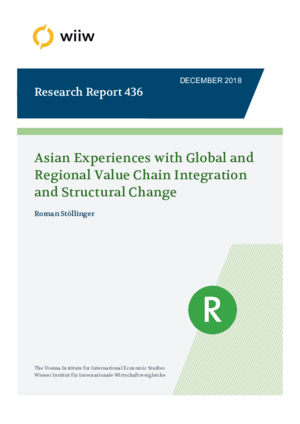Asian Experiences with Global and Regional Value Chain Integration and Structural Change
wiiw Research Report No. 436, December 2018
61 pages including 26 Tables and 10 Figures
This research report investigates the relationship between the growing integration into global and regional value chains (VCs) and structural change in the South and South East Asian (SEA) region. The analysis includes a sample of 60 developed and developing countries covered in the OECD’s Inter-Country Input-Output Tables. Focusing on the SEA region, we find the usual inverted U-shaped relationship between the manufacturing share and per capita income. With regards to the impact of growing VC integration, the econometric results suggest a small positive effect of the overall VC integration on the change in the manufacturing share at the global level. Very similar patterns are found for the South and South East Asian region, however, with a large degree of country heterogeneity. The main beneficiaries from VC integration in the region in terms of the relative importance of manufacturing in the economy include for example Korea and Thailand. Unexpectedly, no significant differences in the (manufacturing-related) structural impacts of regional and global VCs could be identified.
Keywords: global value chains, structural change, competitiveness, economic development
JEL classification: F15, F60, F63, O19, O25
Countries covered: Asia, China, Hong Kong SAR, India, Indonesia, Japan, Malaysia, Philippines, Singapore, South Korea, Taiwan, Thailand, Brunei, Cambodia, Vietnam
Research Areas: International Trade, Competitiveness and FDI
